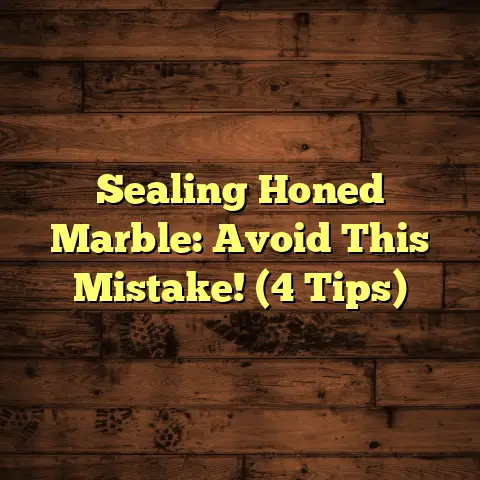Best Peel-and-stick Floor Tiles For Renters? (Explained)
In our busy lives, finding the perfect flooring solution can be a real challenge, especially for renters.
I’ve been there—trying to make a space feel like home without the commitment of permanent changes.
That’s where peel-and-stick floor tiles come in.
They’re a fantastic option for those of us who want something stylish, practical, and easy to install without breaking the bank or violating lease agreements.
Choosing Peel-and-Stick Floor Tiles
When I first started using peel-and-stick tiles, I was drawn to their versatility and ease of installation.
You simply peel off the backing and stick them down—no glue, no mess.
But with so many options available, how do you choose the best ones for your space?
I remember my first experience with these tiles.
I was working on a small apartment in the city, and the worn-out carpet had to go.
The landlord wouldn’t allow any major renovations, but I needed a change.
After some research, I decided to try peel-and-stick tiles.
I loved the idea of being able to transform a room without any heavy lifting or permanent changes.
My Favorite Brands and Styles
Over time, I’ve experimented with various brands and styles.
Here are a few that stood out:
1. Achim Home Furnishings Nexus
These tiles are affordable and come in various designs, from modern patterns to classic wood looks.
I used them in a kitchen remodel, and they held up well against spills and stains.
Each tile measures 12” x 12”, making them easy to cut for precise fits around edges.
2. FloorPops
For something a bit more stylish, FloorPops offers trendy designs that can elevate any room.
I once used their hexagonal tiles in a bathroom project.
The installation was straightforward, and the unique design drew compliments from everyone who visited.
3. Smart Tiles
If you’re looking for something that mimics traditional tile but with an easier application, Smart Tiles are an excellent choice.
They offer a variety of options that look incredibly realistic.
I was skeptical at first but was amazed at how well they worked in my own home.
Installation Tips
Installing peel-and-stick tiles is straightforward, but I’ve learned a few tricks along the way:
- Preparation is Key: Make sure your surface is clean and dry before starting.
I once rushed this step, and it led to some tiles lifting after a few weeks. - Plan Your Layout: Before you stick anything down, lay out your tiles in the desired pattern to see how they’ll fit together.
This helps avoid awkward cuts at the end. - Use a Straight Edge: When cutting tiles, using a straight edge ensures clean lines and prevents jagged edges that can ruin the look.
- Roll Over Tiles: After placing them down, use a roller or even your hands to press down firmly.
This helps eliminate air bubbles and ensures better adhesion.
Cost Considerations
Cost estimation can sometimes be tricky, especially when managing multiple projects.
Here’s where FloorTally comes into play for me.
It simplifies the budgeting process by pulling local material and labor rates, which allows me to provide accurate estimates to my clients right from the start.
For example, while working on a recent project in a rental unit, I estimated that using peel-and-stick tiles would cost around $2-$4 per square foot, depending on the brand and design chosen.
With FloorTally’s help in calculating these costs, I could give my client an upfront total including materials and installation without any hidden surprises later on.
Challenges Faced
Of course, it hasn’t always been smooth sailing.
One challenge I’ve faced is dealing with uneven subfloors.
In one instance, I installed tiles over an old vinyl floor that had some bumps.
After a few months, some edges began to lift because they weren’t sticking properly.
To resolve this, I had to pull up the affected tiles and level out the surface before reapplying new ones.
Maintenance Tips
Maintaining your peel-and-stick floor tiles is quite simple:
- Regular Cleaning: Use a mild cleaner and damp mop regularly to keep them looking fresh.
Avoid harsh chemicals that could damage the adhesive. - Promptly Address Spills: Wipe up spills immediately to prevent staining or damaging the tiles.
- Avoid Excessive Water: These tiles can handle some moisture, but too much water can seep into the seams and weaken the adhesive over time.
Comparing Options
I’ve also experimented with other flooring options like laminate and luxury vinyl plank (LVP), but peel-and-stick tiles have won me over for rental situations due to their affordability and ease of removal.
- Laminate: While great for permanent installations, laminate often requires glue or nails and isn’t suitable for renters looking for flexibility.
- LVP: Although LVP is durable and water-resistant, it typically involves more complex installation procedures that may not be feasible for temporary solutions.
Specific Projects and Experiences
To provide more context on my experiences with peel-and-stick tiles, let me share some specific projects that highlight both successes and challenges.
Kitchen Makeover
A few months ago, I worked on a kitchen makeover for a couple who wanted to spruce up their rental without spending too much.
They had dull linoleum flooring that made the space feel outdated.
We chose Achim Home Furnishings Nexus tiles in a rustic wood look that perfectly matched their cabinets.
The installation was relatively quick; it took us about four hours to cover approximately 100 square feet.
They were thrilled with how easy it was to transform their kitchen into a warm and inviting space.
However, we did encounter some issues when we realized that the subfloor had some imperfections.
We had to take extra time leveling it out before laying down the tiles.
Bathroom Revamp
In another project, I helped a friend revamp her small bathroom.
She wanted something trendy without spending a fortune on traditional tile.
We opted for FloorPops’ hexagonal tiles, which gave her bathroom a modern flair.
This job was slightly more complicated since we had to work around fixtures like the toilet and sink.
The key here was patience; we measured twice and cut carefully to ensure everything fit perfectly.
The result?
A stunning bathroom transformation that felt like a spa retreat.
Living Room Update
One of my favorite projects involved updating my own living room.
After years of neutral tones, I decided to go bold with Smart Tiles that mimicked traditional ceramic tiles but with vibrant colors.
The installation took over two days as I meticulously planned the layout for visual impact.
Every time someone walks into my living room now, they compliment the flooring!
However, I did learn an important lesson about choosing colors; dark colors tend to show dust more than lighter shades.
Advanced Installation Techniques
As I progressed in my flooring journey, I discovered advanced installation techniques that could elevate my projects even further:
- Staggered Patterns: For a more natural look, consider staggering your tile placement rather than aligning them perfectly in rows.
This technique can be particularly effective with wood-look tiles. - Grouting: Some peel-and-stick tile manufacturers offer faux grout options that can add an authentic touch to your design.
While these aren’t necessary for adhesion, they help improve aesthetics significantly. - Sealing Edges: In areas prone to moisture, like kitchens or bathrooms, sealing the edges of your tiles can enhance durability and longevity.
- Transition Strips: If you’re transitioning from one type of flooring to another (like from tile to carpet), using transition strips can create a seamless look while protecting your edges from wear.
Dealing with Common Problems
Even with careful planning and execution, there are common problems that may arise with peel-and-stick flooring:
- Lifting Tiles: If you notice tiles lifting at the edges after installation, it could be due to moisture or improper adhesion during installation.
Carefully reapply adhesive beneath the lifted edge and press down firmly. - Scratches or Scuffs: Regular wear can lead to scratches on your tiles over time.
Using felt pads under furniture legs can help minimize this issue. - Dirt Accumulation: Dirt can accumulate in seams if not cleaned regularly.
A soft broom or vacuum helps keep surfaces clean without damaging the adhesive.
Eco-Friendly Options
If you’re concerned about environmental impact, there are eco-friendly peel-and-stick options available:
- Recycled Materials: Some brands use recycled vinyl or other sustainable materials in their products.
- Low VOCs: Look for products labeled as low in volatile organic compounds (VOCs) to ensure better indoor air quality after installation.
Personal Insights and Recommendations
Throughout my journey as a flooring contractor specializing in peel-and-stick installations, I’ve gained valuable insights that might benefit others considering this option:
- Research Before Buying: Not all peel-and-stick tiles are created equal.
Read reviews and check product specifications before making a purchase. - Invest in Quality: While it might be tempting to go for the cheapest option available, investing in quality materials often pays off in durability and appearance.
- Don’t Rush Installation: Taking your time during installation will lead to better results overall; this is not a project you want to rush through!
- Get Creative: Don’t hesitate to mix patterns or colors!
Peel-and-stick tiles offer endless possibilities for personalization. - Document Your Work: Take before-and-after photos of your projects!
It’s rewarding to see how much of a difference you made—and it can also serve as great marketing material if you decide to showcase your work online.
Conclusion
Peel-and-stick floor tiles have become one of my go-to solutions for renters wanting to spruce up their spaces without committing to permanent changes.
They offer a wide range of styles, easy installation, and affordability that aligns perfectly with rental needs.
Whether you’re refreshing a kitchen or giving a bathroom a quick update, these tiles provide instant gratification and can transform your space in just a weekend.
If you’re considering this option, just remember to prepare your surfaces well and don’t rush the installation process.
Your future self will thank you!





